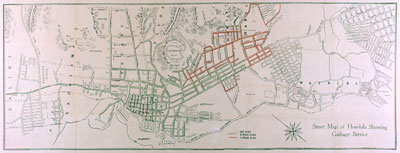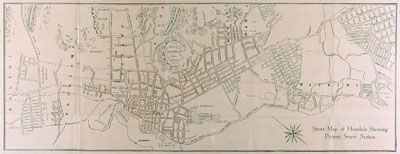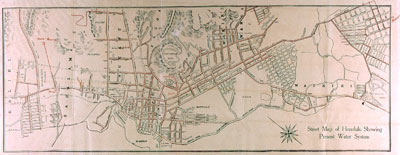Demonstration Papers: Dis-ease and Modernity
The two themes under consideration here are modernization (and its corollary, modernity) and social control during the first two decades of the 20th century. Modernization has been synonymous with the disintegration of tradition and the challenge that it represents to a sense of local (as in regional and specific) identity. Beginning in the late 19th century through the opening years of the 20th, Hawai'i experienced dramatic and rapid changes in its population and in the consolidation and development of its industries. With annexation, laws and customs of the Kingdom of Hawai'i were irrevocably replaced by those of the United States. These changes are reflected in the physical and social alterations prescribed in legal and governmental documents and manifested in visual documents.

Control, the second theme, was the chief topic in the Board of Health reports and operated on many levels in the regulation and restriction of space (the demarcating of what constitutes the center of Honolulu and in turn, the outlying regions and the corresponding services and restrictions that apply; water management and early zoning and land use); the monitoring of substances (food, drugs, food animals) and practices (medicine, dentistry, the handling of the dead); regulations regarding dwellings; bureaucratic practices (registry of births, deaths, marriages; the management of lepers, children, prostitutes; restrictions regarding laundries, poi manufacturing; the construction of places for, and the management of, the diseased, the insane, and "common nuisances"). This control was designed to "protect" certain segments of the population considered to be dangerous to themselves and to the general and "innocent" public: the diseased, the feeble, and the helpless.

Also considered noteworthy were those who exercised control over others. Such monitors were
publicly appointed, such as the registrars, board members; others were agents who were hired
or performed honorific and charitable duty. There were police factions and judicial officers;
covert groups who were expected to monitor others as part of their professions, such as school
inspectors and teachers, and others still, who wished to participate in keeping order and were
rewarded with bounties. Reminiscent of Foucault's work on surveillance, regimes of power, and
the strange ordering of things is the organization of the reports themselves; for example, the
regulations regarding the insane are followed by one on prostitutes, which precedes the section
on diseased animals. Contagious disease was carefully monitored: "All persons examined by
this Board of Examining Physicians shall be placed in one of the following classifications, viz.:
a. Not a Leper;
b. Suspect;
c. Leper."

Contexts
Discussions of modernity routinely include commentary about the importance of photography since
the nature of photography, as well as the uses to which it was put, reflects the dominant concerns
and attitudes of this period. Photography seemed to offer an unimpeachably objective, accurate,
and scientific record of what was, and it offered yet another means of control. As records of
places, faces, and events, photographs were used as evidence and proof that could be enlisted in
the service of various agendas. Thus not only the product but the practice of photography can be
understood as an important context for this research project.

Like other cities in the U.S. during this time period, Honolulu had large immigrant populations, inadequate housing, serious public health concerns, and increased crime and immorality, and so a working acquaintance with the history and development of cities during this period would be useful. The increasing bureaucratization of American life is also part of what is unfolding in Territorial Hawai'i.
Resources
A. J. C. Maynes The Imagined Slum (Leicester: Leicester University Press, 1993) examines
several urban areas through newspaper accounts. The dominant imagery, visual and verbal, that
Mayne offers in his text is useful in examining the perceptions of the slum areas and their
inhabitants in Honolulu. Naturally, one would consult Honolulu newspapers and a variety of
Hawai'i government reports. Some reading in Territorial law, particularly as it is referenced
in the Board of Health reports would be useful as well.
What is proposed in this demonstration paper is to place visual documents at its center. Usually, visuals, most especially photographs, are an afterthought in the construction of research projects. As an article is being written or upon its completion, the researcher will often seek out images that can illustrate, either literally or approximately, her text, and too often she pays little attention to the image itself beyond its facticity. In this demonstration paper, the goal would be to provide critical analyses of the maps and photographic images as one would written texts. Fire insurance maps in conjunction with city directories, which offer detailed information the businesses in sections of Honolulu, are available at Hamilton's Map Collection and the State Archives respectively. Photographs are housed at Bishop Museum and the State Archives. Some of these visual documents are included in this manual, and more of them are available at the website.
